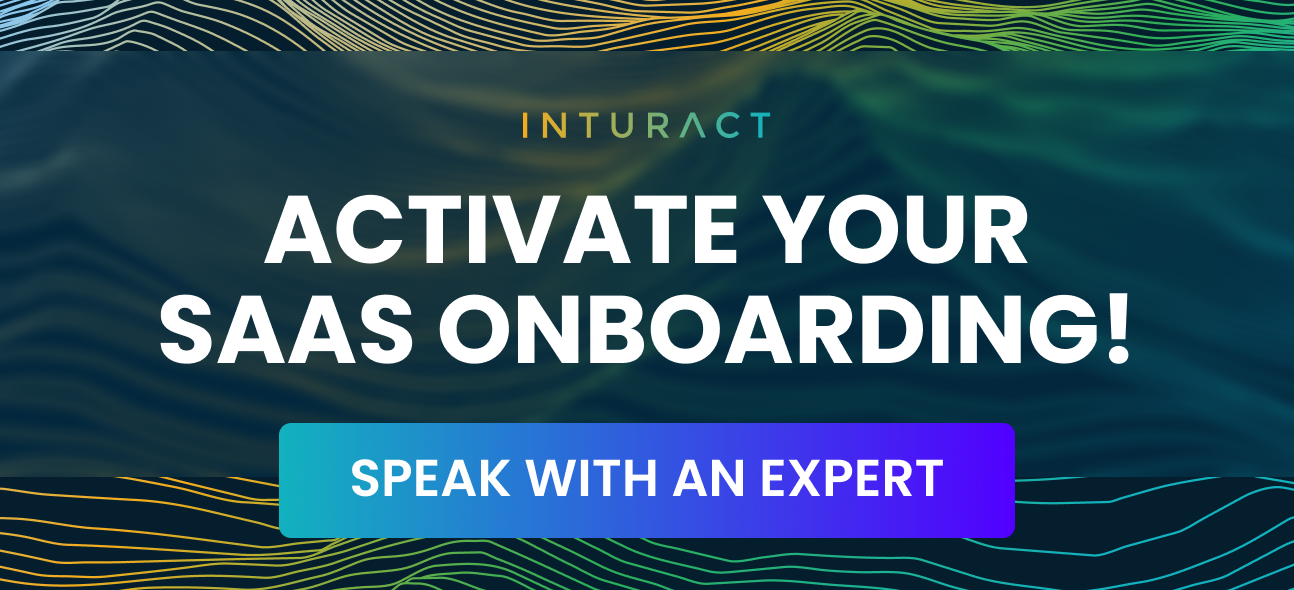In this blog, we'll look at five practical strategies to improve customer retention. Whether you're losing customers faster than you'd like, or just want to improve your retention rates, you'll find valuable insights here. Let's dive in and start turning your churn problem around.
User Onboarding and Training
This strategy involves guiding new users to find value in your product.
Successful user onboarding usually consists of a sequence of elements that help users reach the activation stage:
- Sign-up pages are the first touchpoints where users create their accounts. Keeping them frictionless is important to get users inside the product without delays.
- Welcome screens are the first thing users see in the product. They should always include a call to action prompting users to complete their first task.
- Onboarding checklists appeal to users' psychological need to see things through. Keeping them short and focused on key tasks is effective.
- Interactive walkthroughs take users through key functionalities relevant to their use cases and prompt engagement.
- Tooltips are small in-app patterns that can guide users and help them discover features.
The user onboarding process starts by understanding the customer's pain points, what success looks like for them, and how your product fits into their workflow. By focusing on the features and use cases most relevant to each customer, you're helping them see tangible benefits from your product right from the start. Here's how it works:
- Identify Customer Pain Points: First, find out what difficulties or frustrations the customer has. This could be anything from inefficiencies in their workflow to specific tasks they struggle with.
- Define Success for the Customer: Understand what success looks like for them. For example, do they want to save time, improve productivity, or achieve specific goals? Knowing this helps you tailor your approach.
- Show How Your Product Fits: Explain how your product can help them overcome their challenges and achieve their goals. This means highlighting the features that are most relevant to their needs.
- Focus on Relevant Features: Instead of overwhelming them with all the features, concentrate on the ones that will provide the most immediate benefits. This helps customers see how your product can make a difference in their work right away.
- Demonstrate Tangible Benefits: As customers start using these relevant features, they will begin to notice the positive impact on their workflow. This could be saving time, reducing errors, or achieving their goals more easily.
- Encourage Full Usage: Once they see the benefits, they are more likely to explore and use all the features of the product. This deeper engagement leads to them getting the maximum value from it.
- Promote Long-Term Use: When customers consistently see how the product helps them, they are more likely to continue using it over time. This means they will stay loyal to your product and keep coming back.
By understanding your customers' needs and showing them how your product can help, you create an onboarding experience that leads to satisfaction and long-term retention.
What type of businesses should use this strategy:
- Best for complex SaaS products with multiple features
- Particularly useful for enterprise-level customers who need more hand-holding
- Ideal when your product requires significant behavior change or process adjustment
Loyalty Programs and Exclusive Benefits

In the B2B SaaS world, where switching costs can be high but competition is fierce, loyalty programs and exclusive benefits can be a powerful retention tool. This strategy involves creating a structured program that rewards long-term customers with special perks, discounts, or exclusive features.
Instead of points or punch cards you get in B2C products, think about what would truly benefit your customers. This could include access to exclusive features, priority customer support, or complimentary consulting hours. For example, you might offer customers who have been with you for a year free access to a new advanced feature for a limited time.
Exclusive benefits can also take the form of educational resources. Webinars with industry experts, access to proprietary research, or invitation-only networking events can all add value beyond your core product offering. These benefits not only incentivize customers to stay but also help them derive more value from your ecosystem, further embedding your solution into their operations.
A well-designed loyalty program can provide valuable data about your most engaged customers. This information can inform your product development, marketing strategies, and even your ideal customer profile.
What type of businesses should use this strategy:
- Works well in competitive markets where customers have multiple options
- Particularly effective for SaaS products with tiered pricing models
- Useful when you have a range of add-ons or complementary services to offer
A Community of Users
Creating a community can take many forms. You might set up a Facebook group, moderate a subreddit, or run a Slack channel. The platform doesn't matter as much as the engagement it fosters. Take Ahrefs, for example. They've built a 15,300-member Facebook group exclusively for paying customers. It's a hub for product updates, queries, and tips on using their tools effectively.
Source: ahrefs.com
Why does this strategy work so well?
It goes beyond transactional relationships. When customers feel connected to your brand and other users, they're less likely to churn. They've invested not just money, but time and relationships. Leaving becomes harder when your product is woven into their professional network.
Communities also enable peer-to-peer support. In Ahrefs' group, users often help each other with product or SEO questions. This not only reduces the strain on customer support but also creates a sense of camaraderie among users.
For SaaS companies, these communities are goldmines of feedback and ideas. You get real-time insights into how customers use your product and what features they'd like to see. SaaS companies could also collect feedback directly from its stakeholders as well. An AI form builder might be useful for creating a feedback form for this purpose.
What type of businesses should use this strategy:
- Companies with complex products that can benefit from peer-to-peer learning
- Businesses in industries where professional networking and shared experiences are valuable
- Companies aiming to enhance customer satisfaction and engagement while potentially reducing support costs
Data-Driven User Understanding
A critical strategy for improving retention is to deeply understand what keeps your most engaged users coming back and then to find more people just like them. This approach is not about casting the widest net, but rather about fishing in the right pond.
By diving deep into your user analytics, you can uncover patterns and characteristics of your most loyal and active users. What features do they use most? How often do they log in? What problems are they solving with your tool? These insights are gold.
Once you've identified these patterns, you can use them in two powerful ways:
- Improve your product: Enhance the features and experiences that your best users love. This makes your tool even more valuable to them, further cementing their loyalty.
- Refine your targeting: Use these insights to guide your marketing and sales efforts. Instead of trying to appeal to everyone, focus on finding and attracting more users who match the profile of your most engaged customers.
This strategy requires a shift in mindset. Instead of chasing growth at all costs, you're focusing on sustainable growth with users who are most likely to stick around and get real value from your product.
Implementing this approach requires robust analytics, the ability to interpret complex data, and the willingness to potentially say "no" to certain market segments or features that don't align with your core value proposition. But the payoff can be significant: higher retention rates, more efficient marketing spending, and a strong word-of-mouth effect.
Offer Top-notch Customer Support

Think about the last time you had a great customer support experience. How did it make you feel? Chances are, it left you with a positive impression of the company. Now, imagine if every interaction with a company felt that way. That's the power of unrivaled customer support in B2B SaaS.
When a customer reaches out for help, it's often because something's not working right. They're frustrated, and maybe even considering jumping ship to a competitor. But great support can turn this moment of crisis into an opportunity to strengthen your relationship.
- Start by being quick and available.
- Aim to respond to issues within an hour during business hours, and if possible, offer 24/7 support.
- Use multiple channels like email, live chat, and phone to let customers reach out in ways they prefer.
- Train your support team thoroughly on your product so they can solve problems efficiently.
- Personalize your approach by remembering customer history and using their names
By responding quickly, solving problems effectively, and showing genuine care, you're not just fixing an issue. You're building trust. You're showing customers that you've got their back, that you're committed to their success.
Who should use this strategy:
- SaaS companies with complex or mission-critical products
- Businesses looking to differentiate themselves in crowded markets
Get Help From Experts
This is where specialized partners like Inturact can be invaluable. Inturact is a data-driven growth partner for SaaS companies that are committed to helping products overcome stagnation and achieve sustainable growth.
Unlike many other growth consultants, Inturact offers solutions only after thoroughly examining your data. This approach ensures that the strategies are based on solid evidence rather than guesswork. We bring together 15+ years of industry expertise with data science and machine learning to diagnose exactly why your product isn't growing and then provide the exact playbook you need to get unstuck.
Whether you need help with marketing, onboarding, churn reduction, or pricing analysis, we can provide the insights and execution support you need to grow at a rate you've not seen before.
Schedule a call with Inturact today and let us show you your growth potential.



